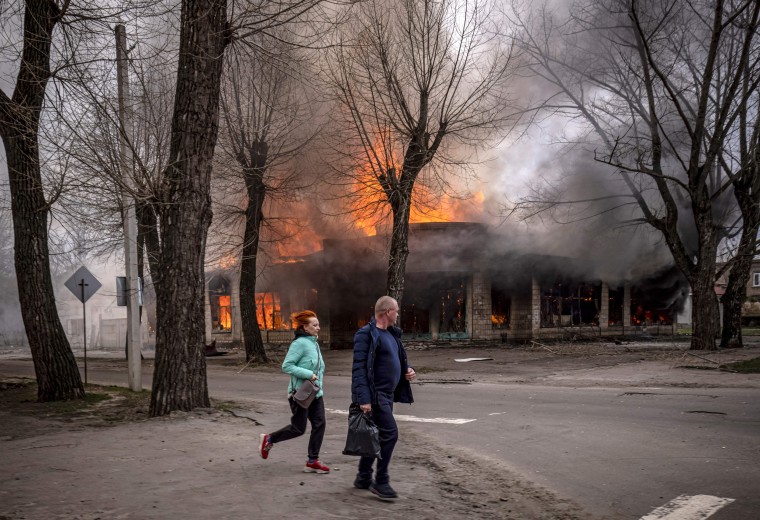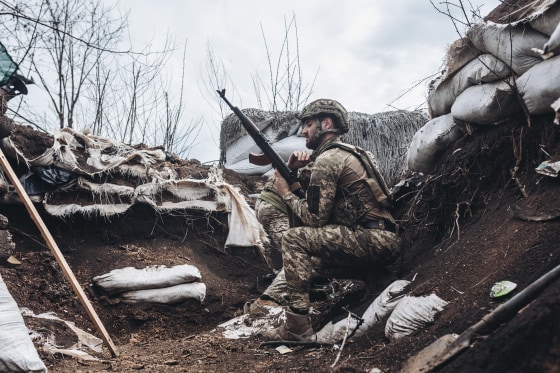In the areas around Kyiv and throughout northern Ukraine, residents are counting the dead as officials clear streets of mines and the twisted frames of tanks from the battles their country has survived.
But experts say Russia's war looks set to enter a potentially more brutal and focused phase in the east, as fighting shifts away from Ukraine’s capital and into its industrial heartland.
As Foreign Minister Dmytro Kuleba put it on NBC News’ “Meet the Press” on Sunday: “Ukraine won the battle for Kyiv. Now, another battle is coming: the battle for Donbas.”
'A decisive battle'
Russia said last month it would end its country-wide assault on Ukraine and focus on the east — the “liberation” of Russian-speaking people there was among President Vladimir Putin’s original justifications for his “special military operation.”
Gen. Alexander Dvornikov, a notorious commander who led Russia’s forces in Syria and has a history of targeting civilians, has been appointed to lead the new offensive.
“The redefinition of Russia’s war aims, from the conquest of Ukraine in the guise of a nonsensical ‘denazification,’ has now transformed into a more limited objective of conquering the eastern provinces,” said Keir Giles, a defense analyst with Chatham House, a think tank in London.
This new strategy means a unified command structure and a clearer, more achievable objective, he said, compared to attempting to invade Europe’s second-biggest country from the north, south and east.
“This means that the danger of Ukrainian forces being surrounded and overwhelmed in the eastern part of the country, which has been present since the very beginning of this campaign, is now even greater,” he said.
“A decisive battle is likely in the near future,” Giles added, as Russia mobilizes units that have not been involved in the fighting so far, as well those being replenished after suffering heavy losses in battles farther north.
Satellite images and Western intelligence briefings suggest Russian forces are gathering for a new assault on the region, as the siege of the strategically vital southeastern city of Mariupol leaves its remaining civilians and defenders facing dire conditions.

As for the battle itself, Kuleba warns it could be very different than the intense street fighting around Kyiv and could more closely resemble World War II, with engagement across open fields and plains, featuring thousands of tanks, planes and armored vehicles. Ukraine is desperate for Western allies to provide more of those war machines sooner rather than later.
Russia’s invasion has slowly pushed back Ukrainian fighters in some areas and secured around 90 percent of the Luhansk region, said Nick Reynolds, a land warfare analyst at the RUSI think tank in London.
Ukraine’s troops have held on more robustly in Donetsk, which together with Luhansk makes up the Donbas region, a swath of which was seized by Russia-backed separatists in 2014. A significant Ukrainian contingent has been dug in since then.
Ukraine will most likely try to avoid open tank battles, using artillery to target supply lines and equipment, and send raiding teams to attack convoys and logistics lines, analysts told Reuters.
“The outcome of the battle could be that both sides will be battered to the point when neither one will be able to conduct an offensive or a counteroffensive,” said Konrad Muzyka, director of Rochan, a consultancy based in Poland.
“Ukrainians will defend their land to the last man.”
Donbas borders Russia to the north and east and is Ukraine's industrial hub — its name is taken from the "Donets Coal Basin" — and ethnic Russians make up about 39 percent of the population, according to Ukraine's 2001 census.
Some commentators believe Putin wants to take the south and east of the country as a way to coerce Ukraine into perhaps making concessions in peace talks, or to gain control of its arms industry and prevent its access to the Black and Azov Seas.
The fight for Mariupol
Mariupol, the key port city that has already seen some of the most intense fighting of the whole war, could be the scene of a crucial battle in the days ahead.
Its mayor, Vadym Boychenko, has said that more than 10,000 civilians had died in the city since the siege began and alleged that Russian forces have been using makeshift crematoriums in the back of trucks to dispose of the sheer number of bodies.
With pressure building on the city's last military defenders and their supplies dwindling, Russia claimed on Wednesday that more than 1,000 Ukrainian marines had surrendered.
NBC News has not verified the claim or the number of those killed.
But the city won’t go down without a fight, experts say.
“They [Russian-backed forces] tried to take Mariupol several times over the course of the last eight years,” said Olga Onuch, an expert in Ukrainian politics at the University of Manchester.
“They’ve tried time and again, and still Mariupol hasn’t surrendered. And even if it does there would be a fightback in future,” Onuch said, raising the prospect of a Ukrainian counterinsurgency in the event of a major Russian victory there.
Russia has already suffered huge losses. NATO estimated that at least 7,000 Russian troops were killed in the first month of the war, along with some key military generals, a figure now sure to be far higher.
After struggling in the first phase of the war, Russia may not find seizing and holding onto eastern Ukraine any easier.
“The population in the eastern part of the country is much more mixed than in Crimea," which Russia annexed in 2014, said Emmanuel Karagiannis, an international security expert at King’s College London. "The occupation of eastern Ukraine would put Moscow in a difficult situation to control a potentially hostile population."
“Second, eastern Ukraine does not have natural borders as opposed to Crimea, which is an easily defensible peninsula. This factor would make the occupation forces vulnerable to cross-border attacks,” he added.
So with Ukrainian President Volodymyr Zelenskyy lauded as a defender of democracy across the world, and with no major city in Russian hands almost seven weeks into this invasion, can the pivot to the east secure some form of victory for Putin?
The conflict is “unwinnable,” according to Onuch, but will likely continue for as long as Russia wants. “Just like the propaganda calls this a ‘special operation’ rather than an extremely violent war that’s targeting civilians, the Kremlin can spin anything into a victory,” she said.
Putin may take some satisfaction, she added, from the prospect of destabilizing Ukraine and destroying its infrastructure, or in thwarting its desire to join NATO.
“To us it might seem irrational, but to him it’s a means to his ends,” she said. “If the means to his ends is the full destruction of Ukraine, then that’s going to be extremely hard."
You can take territory, she said, but "you can’t kill an idea."

